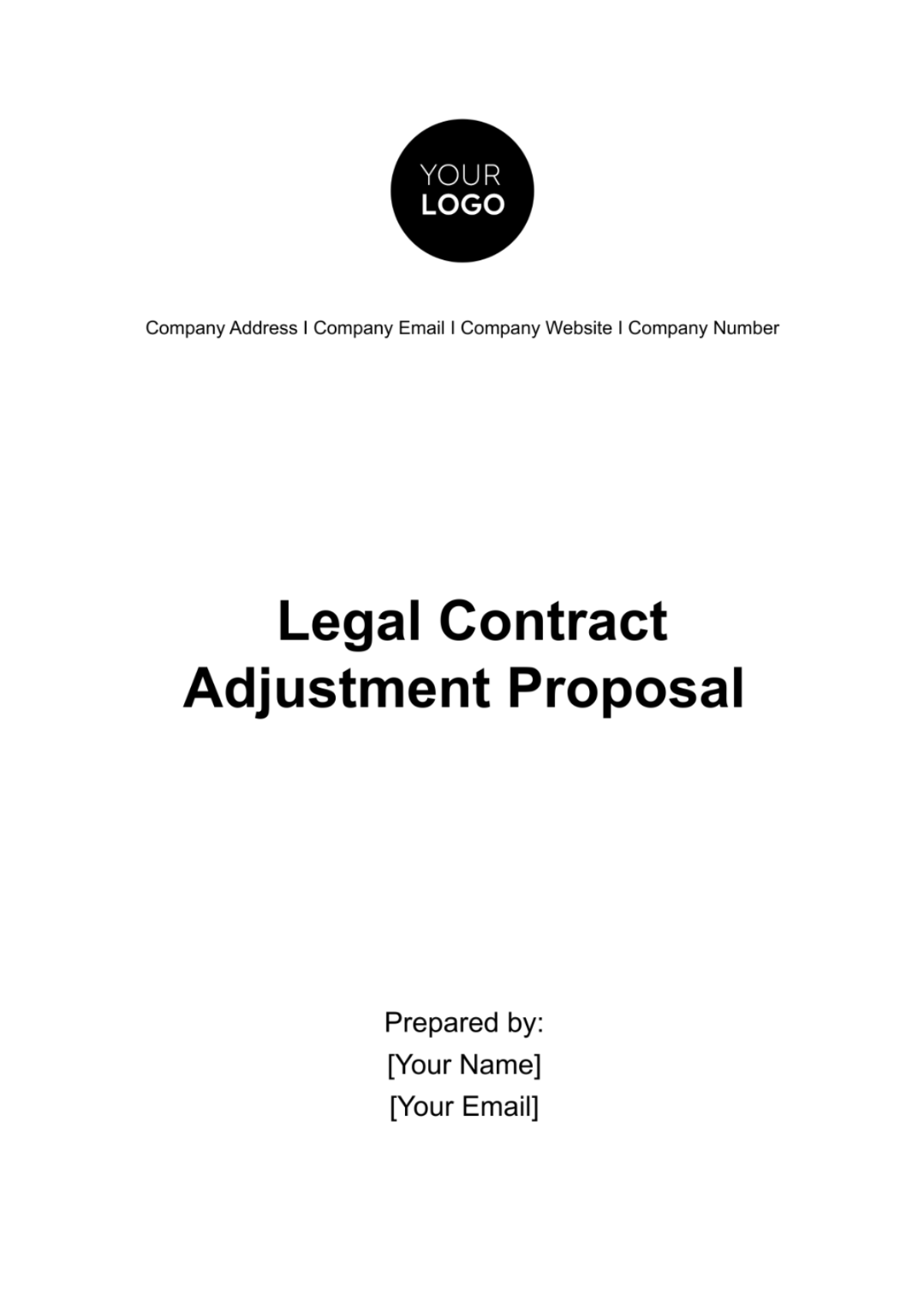Free Legal Contract Adjustment Proposal

1. Introduction
Welcome to the Legal Contract Adjustment Proposal prepared by [Your Company Name]. This document serves as a formal proposition to modify the existing contractual agreement dated [Month, Day, Year], hereinafter referred to as the "Original Contract", between [Your Company Name] and [Other Party's Name]. The dynamic business environment, notably influenced by significant regulatory updates due to the introduction of the General Data Protection Regulation (GDPR) in the European Union and substantial market shifts driven by the accelerated adoption of remote work technologies in response to the global pandemic, necessitates these proposed adjustments. Such changes are pivotal to not only align our ongoing contractual obligations with these new realities but also to fortify the foundation of our partnership, ensuring its continued success and the realization of mutual benefits in this evolved landscape.
2. Background
The Original Contract was established with the intent of facilitating a strategic partnership for the development and delivery of an advanced cloud-based software platform designed to enhance [Your Company Name]'s data analytics capabilities. This ambitious project aimed to leverage [Other Party's Name]'s expertise in cutting-edge cloud technology and artificial intelligence to create a solution that would enable [Your Company Name] to process large datasets more efficiently, thereby gaining deeper insights into market trends and customer behavior. The collaboration was envisioned as a cornerstone of [Your Company Name]'s digital transformation strategy, positioning the company to take a leading role in its industry by harnessing the power of big data and analytics.
However, the subsequent onset of unprecedented global supply chain disruptions, coupled with the rapid technological advancements in artificial intelligence (AI) and machine learning, have presented both significant challenges and unique opportunities. These developments have notably impacted our project timelines, cost structures, and delivery mechanisms, necessitating a comprehensive reevaluation of the contract's current terms.
The supply chain disruptions have led to extended lead times and increased costs for materials essential to our joint project, directly affecting our agreed-upon delivery schedules and financial projections. Concurrently, advancements in AI and machine learning technologies have opened new avenues for enhancing operational efficiency and product innovation within our partnership. These shifts in the operational landscape underscore the need to adjust our contractual terms to accommodate the increased costs and capitalize on emerging technological opportunities. By doing so, we aim to realign our agreement with the evolved operational realities and strategic goals of both parties, ensuring our partnership not only navigates these challenges successfully but also emerges stronger, more agile, and better positioned for future growth.
3. Rationale for Adjustment
The need for adjustment stems from an array of challenges, changes, and new opportunities that have emerged since the inception of our original agreement. Specifically, the global shift towards digital transformation accelerated by the COVID-19 pandemic, alongside significant changes in international trade regulations and supply chain disruptions, have profoundly impacted our operational capabilities and strategic planning.
Evidence Supporting Adjustment:
Market Changes: The pandemic has accelerated the digital transformation across all sectors, increasing the demand for [Your Company Name]'s digital services. However, it has also introduced volatility in market demands and consumer behavior, necessitating more flexible contract terms to allow rapid adaptation to market conditions.
Legal Amendments: Recent amendments in international trade regulations, particularly the imposition of new tariffs and trade barriers between key markets, require adjustments to our supply chain strategy and contractual obligations to mitigate increased operational costs and ensure compliance.
Unforeseen Challenges: Supply chain disruptions have significantly impacted our ability to meet predetermined deadlines and deliverables outlined in the Original Contract. These disruptions, resulting from global logistic challenges and raw material shortages, have underscored the need for revising delivery schedules and penalty clauses to reflect the current reality.
Anticipated Benefits include enhancing the agility of [Your Company Name] to respond to market changes, ensuring compliance with the latest international trade regulations, and mitigating the impact of supply chain disruptions on project timelines and costs. These adjustments are aimed at preserving the integrity of our partnership with [Other Party's Name], ensuring that we can continue to collaborate effectively under these new conditions, and setting a precedent for adaptive and resilient business practices.
4. Proposed Adjustments
We propose the following specific adjustments to the Original Contract, aimed at addressing the challenges and opportunities identified:
Clause No. | Current Wording | Proposed Adjustment | Rationale |
|---|---|---|---|
5.2 | "Deliverables must be completed and delivered by [Month, Day, Year]." | "Deliverables must be completed and delivered by [Month, Day, Year], with provision for extension in case of significant supply chain disruptions or changes in market demand." | This adjustment provides flexibility in the delivery schedule, accounting for the unpredictability of supply chain disruptions and market volatility, ensuring realistic and achievable timelines. |
8.3 | "The buyer shall adhere to standard payment terms of 30 days." | "The buyer is granted a payment term extension up to 60 days during instances of regulatory changes or economic downturns as defined by [specific criteria or indices]." | Extending payment terms during specific challenging economic conditions offers financial flexibility to the buyer, helping maintain cash flow stability and ensuring continued partnership during times of economic uncertainty. |
11.4 | "All services provided under this agreement must comply with current industry standards and regulations." | "All services provided under this agreement must comply with current industry standards and regulations, with a clause for adjustment upon significant regulatory amendments." | Incorporating a mechanism for adjusting service compliance in response to regulatory changes ensures that the services remain compliant and relevant, safeguarding both parties against potential legal and financial risks. |
These proposed adjustments to the contract are designed to address the specific challenges brought about by supply chain disruptions, regulatory changes, and market volatility. By providing for greater flexibility in deliverables, payment terms, and compliance requirements, [Your Company Name] and [Other Party's Name] can better navigate the evolving operational landscape, ensuring the partnership remains robust and mutually beneficial.
5. Legal and Financial Implications
The proposed adjustments have been meticulously reviewed to ensure they align with all applicable laws and regulations, including the General Data Protection Regulation (GDPR) for data handling and privacy, the United States-Mexico-Canada Agreement (USMCA) affecting trade and tariffs, and the International Labor Organization (ILO) standards for employment practices. These legal frameworks have been carefully considered in the drafting of the proposed adjustments to ensure full compliance and to mitigate any potential legal risks associated with international trade, digital services, and employment.
The adjustments are strategically designed to not only safeguard [Your Company Name] and [Other Party's Name] against potential legal repercussions but also to outline a clear financial roadmap for both parties moving forward. This includes:
Adjusting payment terms to reflect current economic challenges, thereby providing [Other Party's Name] with greater liquidity flexibility, which is crucial for maintaining operational stability.
Incorporating flexible delivery schedules allows for adjustments in response to supply chain disruptions, ensuring that financial planning and project budgeting can be more accurately aligned with realistic timelines.
Revising compliance clauses to account for potential regulatory changes, which helps in preempting compliance costs that could arise from new regulations, ensuring that both parties can allocate resources more effectively.
These adjustments aim to provide a balanced approach, recognizing the importance of legal compliance and financial stability in sustaining a successful and mutually beneficial partnership. By proactively addressing these areas, [Your Company Name] and [Other Party's Name] can continue to collaborate with confidence, knowing that their agreement reflects the latest legal standards and financial realities.
6. Implementation Plan
To ensure the effective implementation of the proposed adjustments, a comprehensive plan has been developed. This plan outlines the necessary steps and timeline to transition smoothly to the revised terms, ensuring minimal disruption to ongoing operations and maintaining the integrity of the partnership between [Your Company Name] and [Other Party's Name].
Timeline:
Timeline | Details |
|---|---|
Initial Review and Feedback Period | Two weeks from the proposal submission date, allowing [Other Party's Name] to review and provide feedback on the proposed adjustments. |
Negotiation and Finalization | One month from the proposal submission date, dedicated to negotiating any points of contention and finalizing the adjustments. |
Legal Review and Approval | Two weeks following the finalization of adjustments, ensuring all legal requirements are met and both parties are in agreement. |
Implementation of Adjustments | Set to commence one week after legal approvals, with a phased approach over one month to integrate changes seamlessly into existing operations. |
Approval Process:
Step 1: Both parties review the proposed adjustments independently.
Step 2: A joint meeting is convened to discuss feedback and negotiate terms.
Step 3: Adjustments are refined based on feedback and negotiations.
Step 4: Finalized adjustments undergo legal review by both parties.
Step 5: Official amendments to the contract are drafted and signed.
Dispute Resolution:
In the event of disputes arising from the proposed adjustments, both parties agree to first seek resolution through mediation, utilizing a mutually agreed-upon mediator. If mediation does not result in a resolution, arbitration will be considered as the next step, with the location and arbitrator to be jointly selected.
Conclusion
This Legal Contract Adjustment Proposal represents a proactive and strategic approach by [Your Company Name] to address the evolving challenges and opportunities faced by both our organizations in the current business landscape. The proposed adjustments are designed with the intent of fostering a stronger, more adaptable partnership, capable of navigating the complexities of modern business environments.
We believe that these adjustments not only mitigate potential risks but also unlock new possibilities for growth and collaboration. By embracing flexibility, ensuring compliance, and maintaining a clear financial path forward, [Your Company Name] and [Other Party's Name] can continue to thrive together.
We look forward to engaging in constructive discussions with [Other Party's Name] regarding this proposal. [Your Company Name] is committed to working collaboratively to finalize these adjustments, ensuring they serve the best interests of both parties and lay the groundwork for continued success.
We invite [Other Party's Name] to review this proposal and share their feedback, hopeful that together, we can navigate the future with confidence and achieve greater heights.
- 100% Customizable, free editor
- Access 1 Million+ Templates, photo’s & graphics
- Download or share as a template
- Click and replace photos, graphics, text, backgrounds
- Resize, crop, AI write & more
- Access advanced editor
Optimize contract modifications with Template.net's Legal Contract Adjustment Proposal Template. Skillfully designed for precision and adaptability, this template is fully customizable and editable through our AI Editor Tool. Facilitate seamless contract updates, ensuring proposals are clear and legally sound. Advance your contract management practices with the innovative and user-friendly solutions from Template.net.
You may also like
- Business Proposal
- Research Proposal
- Proposal Request
- Project Proposal
- Grant Proposal
- Photography Proposal
- Job Proposal
- Budget Proposal
- Marketing Proposal
- Branding Proposal
- Advertising Proposal
- Sales Proposal
- Startup Proposal
- Event Proposal
- Creative Proposal
- Restaurant Proposal
- Blank Proposal
- One Page Proposal
- Proposal Report
- IT Proposal
- Non Profit Proposal
- Training Proposal
- Construction Proposal
- School Proposal
- Cleaning Proposal
- Contract Proposal
- HR Proposal
- Travel Agency Proposal
- Small Business Proposal
- Investment Proposal
- Bid Proposal
- Retail Business Proposal
- Sponsorship Proposal
- Academic Proposal
- Partnership Proposal
- Work Proposal
- Agency Proposal
- University Proposal
- Accounting Proposal
- Real Estate Proposal
- Hotel Proposal
- Product Proposal
- Advertising Agency Proposal
- Development Proposal
- Loan Proposal
- Website Proposal
- Nursing Home Proposal
- Financial Proposal
- Salon Proposal
- Freelancer Proposal
- Funding Proposal
- Work from Home Proposal
- Company Proposal
- Consulting Proposal
- Educational Proposal
- Construction Bid Proposal
- Interior Design Proposal
- New Product Proposal
- Sports Proposal
- Corporate Proposal
- Food Proposal
- Property Proposal
- Maintenance Proposal
- Purchase Proposal
- Rental Proposal
- Recruitment Proposal
- Social Media Proposal
- Travel Proposal
- Trip Proposal
- Software Proposal
- Conference Proposal
- Graphic Design Proposal
- Law Firm Proposal
- Medical Proposal
- Music Proposal
- Pricing Proposal
- SEO Proposal
- Strategy Proposal
- Technical Proposal
- Coaching Proposal
- Ecommerce Proposal
- Fundraising Proposal
- Landscaping Proposal
- Charity Proposal
- Contractor Proposal
- Exhibition Proposal
- Art Proposal
- Mobile Proposal
- Equipment Proposal
- Student Proposal
- Engineering Proposal
- Business Proposal





























